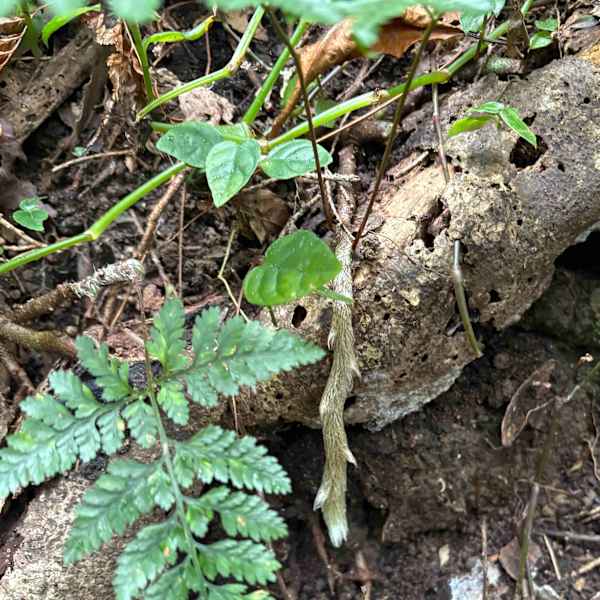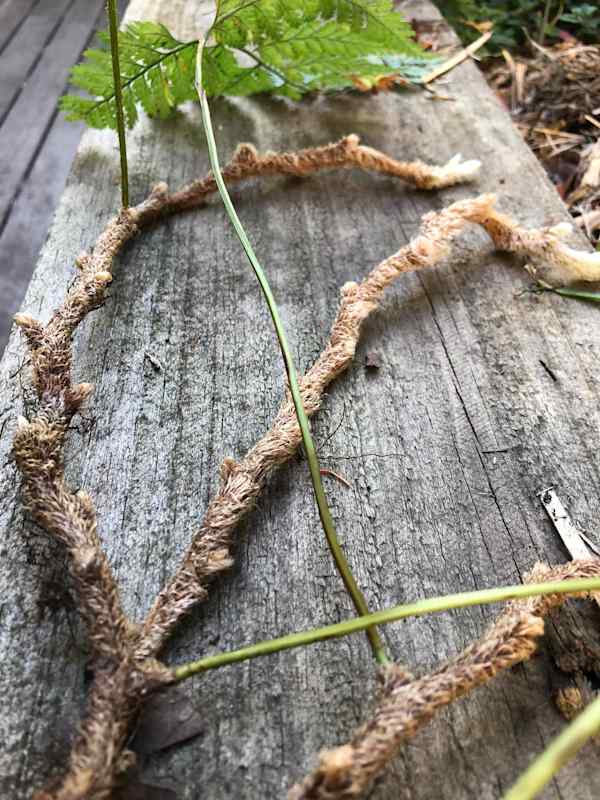In some cultures, carrying a rabbit's foot has been considered to bring good luck. Perhaps it still is? I've certainly never tried carrying one around, but I'm always reminded of this bit of folklore when I see one of my favourite local ferns around the Illawarra. The Hare's Foot Fern, Davallia solida var. pyxidata, is easily recognisable because its rhizomes look rather like little hares' or rabbits' feet. Particularly if you don't know exactly what those feet look like, or the precise differences between them.
Judge for yourself from the picture below.

Sometimes the rhizomes are pale, as in the above picture, particularly when young, while older rhizomes are covered with dark brown or black hair-like scales. Either way, it's the loveliest thing to see, and always makes me smile and feel a bit better about everything, because it's so soft, and furry, and footlike, and so so interesting.
In case you're wondering, rhizomes are stems that can produce roots and shoots (more stems). With ferns, the appearance of the rhizome is often used to tell different species apart. Most often ferns' rhizomes grow underground, or just at the surface of the soil, and need to be unearthed if you want to check them for identification.
Hare's Foot Fern is something of an exception though, and its rhizomes are often visible above ground, making identification straightforward. This fern is also quite common in NSW and can be seen in many local parks and reserves, often growing on rocks, or right up in the forks of tall trees, where it mingles with orchids and other tree-dwelling ferns.
Here's a really big specimen up a tree!

But back to that sense of well-being. It's not only the Hare's Foot Fern that brings calm and happiness, though that species is emblematic for me. It's being in local forests and woodlands, and breathing in the cool, moist air, away from the rush and tumult of the city.
Study after study after study has demonstrated the benefits of spending time in nature, on physical and mental health. While the research is still evolving, it's very clear that both children and adults benefit from being in nature. There is even a growing field of 'nature prescribing' in which health professionals recommend people spend time in nature or outdoors (often in conjunction with other treatment options).
This article in the Australian Journal of General Practice, by Illawarra experts Rowena Ivers and Thomas Astell-Burt, describes the process of nature prescribing for GPs, although many of the recommendations don't involve being out in bushland (and I can't see any specific mention of the Hare's Foot Fern!).
Some studies look specifically at the benefits of being in forests. A few have found that spending time walking or contemplating in a forest reduces levels of stress hormone in the human body, while a 2014 meta-analysis by Colin Capaldi, Raelyne Dopco and John Zelenski found a positive correlation between feeling connected with nature and a sense of happiness or wellbeing. So, if you haven't already, it's time to go out and make friends with those ferns.






